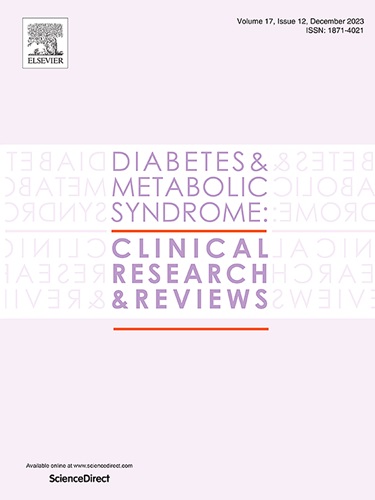Malnutrition-related diabetes mellitus: Rushing toward “type 5” amid unresolved questions and limited evidence
IF 3.4
Q1 ENDOCRINOLOGY & METABOLISM
Diabetes & Metabolic Syndrome-Clinical Research & Reviews
Pub Date : 2025-05-01
DOI:10.1016/j.dsx.2025.103250
引用次数: 0
Abstract
Aim
To critically evaluate the historical context, diagnostic ambiguity, epidemiological relevance, and recent proposals to reclassify malnutrition-related diabetes mellitus (MRDM) amid changing nutritional landscapes and existing metabolic data.
Methods
This review synthesizes data from early clinical reports, WHO documents, epidemiological studies, and recent literature on malnutrition and diabetes. Emphasis is placed on diagnostic inconsistencies, the overuse of low BMI as a surrogate for malnutrition, and evolving nutrition trends in India and low- and middle-income countries (LMICs).
Results
MRDM was initially associated with protein-energy malnutrition, low BMI, and insulin-requiring but ketosis-resistant diabetes. However, overlap with other diabetes types, especially autoimmune forms, has raised doubts about its distinct identity. Low BMI is an unreliable proxy for malnutrition in often constitutionally lean populations in LMICs. A 2022 study suggested insulin secretory defects in MRDM, but was limited by small, male-only samples and lack of follow-up. Proposals to classify MRDM as “type 5 diabetes” are questionable, as types 3 and 4 lack formal recognition. Moreover, declining undernutrition rates in LMICs further diminish MRDM's current relevance. Emerging evidence also indicates malnutrition may be more often a consequence than a cause of diabetes.
Conclusion
Given its heterogeneity, diagnostic uncertainty, and diminishing epidemiological significance, reclassifying MRDM as a distinct type of diabetes (“type 5 diabetes”) is presently unwarranted. Future classification efforts should prioritize data-driven subtypes with clear therapeutic and prognostic implications, rather than reviving outdated constructs with limited contemporary utility.
营养不良相关的糖尿病:在尚未解决的问题和有限的证据中冲向“5型”
目的在不断变化的营养状况和现有代谢数据的背景下,批判性地评估营养不良相关糖尿病(MRDM)的历史背景、诊断的模糊性、流行病学相关性以及最近提出的重新分类建议。方法本综述综合了早期临床报告、世卫组织文件、流行病学研究和最近关于营养不良和糖尿病的文献。重点是诊断不一致,过度使用低BMI作为营养不良的替代指标,以及印度和低收入和中等收入国家(LMICs)不断变化的营养趋势。结果smrdm最初与蛋白质能量营养不良、低BMI和需要胰岛素但酮症抵抗的糖尿病相关。然而,与其他类型的糖尿病,特别是自身免疫性糖尿病的重叠,引起了对其独特身份的怀疑。在中低收入国家体质瘦弱的人群中,低BMI是一个不可靠的营养不良指标。2022年的一项研究表明,MRDM存在胰岛素分泌缺陷,但受限于样本量小,仅限男性,且缺乏随访。将MRDM归类为“5型糖尿病”的建议值得怀疑,因为3型和4型缺乏正式的认可。此外,中低收入国家营养不良率的下降进一步削弱了MRDM目前的相关性。新出现的证据还表明,营养不良可能更多地是糖尿病的后果,而不是原因。鉴于其异质性、诊断不确定性和流行病学意义的降低,将MRDM重新分类为一种独特的糖尿病(“5型糖尿病”)目前是没有根据的。未来的分类工作应优先考虑具有明确治疗和预后意义的数据驱动亚型,而不是恢复具有有限当代效用的过时结构。
本文章由计算机程序翻译,如有差异,请以英文原文为准。
求助全文
约1分钟内获得全文
求助全文
来源期刊

Diabetes & Metabolic Syndrome-Clinical Research & Reviews
ENDOCRINOLOGY & METABOLISM-
CiteScore
22.90
自引率
2.00%
发文量
248
审稿时长
51 days
期刊介绍:
Diabetes and Metabolic Syndrome: Clinical Research and Reviews is the official journal of DiabetesIndia. It aims to provide a global platform for healthcare professionals, diabetes educators, and other stakeholders to submit their research on diabetes care.
Types of Publications:
Diabetes and Metabolic Syndrome: Clinical Research and Reviews publishes peer-reviewed original articles, reviews, short communications, case reports, letters to the Editor, and expert comments. Reviews and mini-reviews are particularly welcomed for areas within endocrinology undergoing rapid changes.
 求助内容:
求助内容: 应助结果提醒方式:
应助结果提醒方式:


